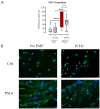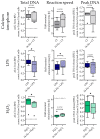NET Formation Was Reduced via Exposure to Extremely Low-Frequency Pulsed Electromagnetic Fields
- PMID: 37834077
- PMCID: PMC10572227
- DOI: 10.3390/ijms241914629
NET Formation Was Reduced via Exposure to Extremely Low-Frequency Pulsed Electromagnetic Fields
Abstract
Fracture-healing is a highly complex and timely orchestrated process. Non-healing fractures are still a major clinical problem and treatment remains difficult. A 16 Hz extremely low-frequency pulsed electromagnetic field (ELF-PEMF) was identified as non-invasive adjunct therapy supporting bone-healing by inducing reactive oxygen species (ROS) and Ca2+-influx. However, ROS and Ca2+-influx may stimulate neutrophils, the first cells arriving at the wounded site, to excessively form neutrophil extracellular traps (NETs), which negatively affects the healing process. Thus, this study aimed to evaluate the effect of this 16 Hz ELF-PEMF on NET formation. Neutrophils were isolated from healthy volunteers and exposed to different NET-stimuli and the 16 Hz ELF-PEMF. NETs were quantified using Sytox Green Assay and immunofluorescence, Ca2+-influx and ROS with fluorescence probes. In contrast to mesenchymal cells, ELF-PEMF exposure did not induce ROS and Ca2+-influx in neutrophils. ELF-PEMF exposure did not result in basal or enhanced PMA-induced NET formation but did reduce the amount of DNA released. Similarly, NET formation induced by LPS and H2O2 was reduced through exposure to ELF-PEMF. As ELF-PEMF exposure did not induce NET release or negatively affect neutrophils, the ELF-PEMF exposure can be started immediately after fracture treatment.
Keywords: EMF; fracture healing; neutrophil extracellular traps; neutrophils.
Conflict of interest statement
The authors declare no conflict of interest. Sachtleben GmbH provided the ELF-PEMF devices with the technical support but was not involved in the study design or the data evaluation.
Figures





Similar articles
-
Extremely low frequency pulsed electromagnetic fields cause antioxidative defense mechanisms in human osteoblasts via induction of •O2- and H2O2.Sci Rep. 2017 Nov 6;7(1):14544. doi: 10.1038/s41598-017-14983-9. Sci Rep. 2017. PMID: 29109418 Free PMC article.
-
Intermittent Exposure to a 16 Hz Extremely Low Frequency Pulsed Electromagnetic Field Promotes Osteogenesis In Vitro through Activating Piezo 1-Induced Ca2+ Influx in Osteoprogenitor Cells.J Funct Biomater. 2023 Mar 20;14(3):165. doi: 10.3390/jfb14030165. J Funct Biomater. 2023. PMID: 36976089 Free PMC article.
-
Primary human osteoblasts with reduced alkaline phosphatase and matrix mineralization baseline capacity are responsive to extremely low frequency pulsed electromagnetic field exposure - Clinical implication possible.Bone Rep. 2015 Aug 18;3:48-56. doi: 10.1016/j.bonr.2015.08.002. eCollection 2015 Dec. Bone Rep. 2015. PMID: 28377966 Free PMC article.
-
Translational Insights into Extremely Low Frequency Pulsed Electromagnetic Fields (ELF-PEMFs) for Bone Regeneration after Trauma and Orthopedic Surgery.J Clin Med. 2019 Nov 20;8(12):2028. doi: 10.3390/jcm8122028. J Clin Med. 2019. PMID: 31756999 Free PMC article. Review.
-
Is extremely low frequency pulsed electromagnetic fields applicable to gliomas? A literature review of the underlying mechanisms and application of extremely low frequency pulsed electromagnetic fields.Cancer Med. 2023 Feb;12(3):2187-2198. doi: 10.1002/cam4.5112. Epub 2022 Aug 5. Cancer Med. 2023. PMID: 35929424 Free PMC article. Review.
Cited by
-
The Glucagon-Like Peptide-1 (GLP-1) Receptor Agonist Liraglutide Regulates Sirtuin-1-Mediated Neutrophil Extracellular Traps to Improve Diabetes-Induced Bone Metabolism Imbalance.Iran J Pharm Res. 2024 Nov 13;23(1):e148139. doi: 10.5812/ijpr-148139. eCollection 2024 Jan-Dec. Iran J Pharm Res. 2024. PMID: 40066121 Free PMC article.
References
-
- Ziegler P., Nussler A.K., Wilbrand B., Falldorf K., Springer F., Fentz A.K., Eschenburg G., Ziegler A., Stöckle U., Maurer E., et al. Pulsed Electromagnetic Field Therapy Improves Osseous Consolidation after High Tibial Osteotomy in Elderly Patients-A Randomized, Placebo-Controlled, Double-Blind Trial. J. Clin. Med. 2019;8:2008. doi: 10.3390/jcm8112008. - DOI - PMC - PubMed
-
- Caliogna L., Medetti M., Bina V., Brancato A.M., Castelli A., Jannelli E., Ivone A., Gastaldi G., Annunziata S., Mosconi M., et al. Pulsed Electromagnetic Fields in Bone Healing: Molecular Pathways and Clinical Applications. Int. J. Mol. Sci. 2021;22:7403. doi: 10.3390/ijms22147403. - DOI - PMC - PubMed
MeSH terms
Substances
Grants and funding
LinkOut - more resources
Full Text Sources
Medical
Research Materials
Miscellaneous

